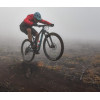Rethinking XC with Yeti’s new ASR

Although the brand has fielded a downcountry bike for the last few seasons, the SB115, Yeti has lacked a dedicated cross-country offering since the previous ASR was discontinued a decade ago.
- Bike check: Nino Schurter's Scott Spark
- Mountain bike etiquette - the lowdown on trail-side manners
- What is downcountry?
Recognising that XC racing has developed apace during the last decade, with XCO race courses becoming much more technical, product planners at Yeti relished the challenge of recreating a contemporary XC version of the ASR.
Although the new ASR matches Yeti’s SB115 downcountry bike for rear travel, at 115mm, the kinematics and suspension design are different. Yeti was a flex stay pioneer back in 2003 and with the new ASR, that engineering tradition regarding the bike’s rear triangle returns.
With flex stays, there are fewer pivots and less weight, meaning the new ASR frame is only 1,552g (without a shock). There is a wireless-specific T-Series option without cable ports for riders who are AXS-for-life, weighing only 1,448g, claims the brand.
Frame specifications include a durable and low-maintenance threaded bottom bracket, chainring compatibility from 28-36t (38t available on the M, L, XL sizes), and room for two hydration bottles in the front triangle. Yeti offers an optional minimalist chain guide, and riders who want to run 2.4in trail-wide tyre casings on 30mm rims won’t encounter any clearance issues.
ASR-specific suspension
The ASR frame is compatible with RockShox’s latest Flight Attendant XC autonomous electronic suspension. Riders who prefer analogue cable-actuated lock-out controls for their rear shock will find a dedicated thru-frame cable path.
Bikes and frames will ship with custom-tuned SIDLuxe FA, SIDLuxe ULT, and SID Luxe Select rear shocks, each featuring a Yeti-specific compression stack, delivering enhanced small-bump performance. The ASR’s rear suspension is engineered to allow full-stroke suspension travel on technical descents, without sacrificing the sensitivity that creates ride comfort and reduces rider fatigue during endurance XC events.
Frame geometry is designed around a 120mm fork, with Yeti’s designers optimizing the ASR to balance climbing efficiency and descending confidence. The 75.5-degree seat angle and 66.5-degree head angle are on-trend for a contemporary XC bike, with reach on a size large being 465mm.
Some Yeti fans might ask: if the ASR and SB115 have similar amounts of suspension travel, how different are they regarding geometry? Interestingly, the new XC bike has more progressive geometry than Yeti’s current ‘downcountry’ frame. Compare the geo charts and ASR has a 1.5-degree slacker head angle and 15.4mm more reach (size L), than an SB115.
The ASR range starts at £5,499 with the C2, rolling DT Swiss M1900 wheels, shifting via a SRAM GX Eagle drivetrain and with a Fox Transfer SL Performance dropper post. The £8,399 T3 adds XO AXS wireless shifting, a Fox Transfer Factory spec dropper and DT XM1700 wheels.
Yeti’s dream build is the £13,990 ASR, featuring a SRAM XX Eagle AXS drivetrain and dropper. Rolling the ASR Ultimate along are the latest DT Swiss XRC 1200 wheels, with Yeti being one of the first brands to bring these to market. The XRC 1200 wheelset weighs only 1303g and spins DT180 hubs with ceramic bearings.
For those Yeti fans interested in the new ASR but keen on doing their own build project or transferring parts across from an existing XC bike, there is the T-Series wireless frame-only option, at £3,799.
We've managed to get some time on the new bike ahead of launch, so check out our Yeti ASR T3 first ride review.














